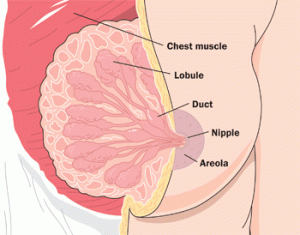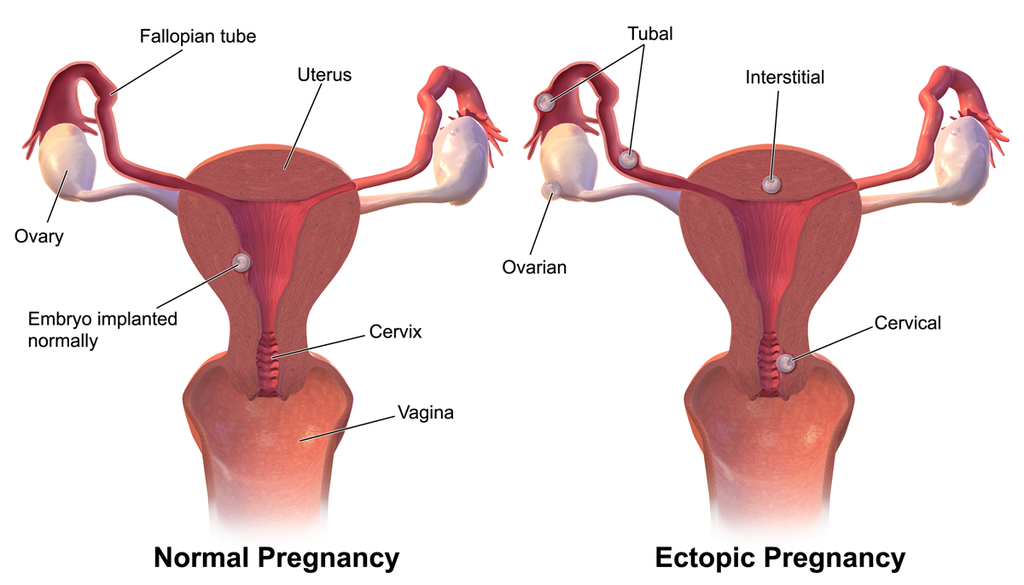6.5 Female Reproductive System
Overview and Functions
The female reproductive system functions to produce gametes and reproductive hormones, making it similar to the male reproductive system. However, it has another function—to support a developing fetus and deliver it to the outside world. Unlike the male reproductive system, the female reproductive system is located primarily inside the pelvic cavity. Figs. 6.15 and 6.16 provide an overview of the main components of the female reproductive system.


(CrashCourse, 2015)
Components of the Female Reproductive System
Vagina: Approximately 10 cm long, the vagina is the muscular entrance to the reproductive tract. It is the exit from the uterus during menses and childbirth. The vagina leads to the cervix, which is the opening to the uterus.
Cervix: This structure connects the lower end of the uterus to the vagina.
Uterus: This muscular organ nourishes and supports the growing embryo. On average, it is approximately 5 cm wide and 7 cm long.
Ovaries: These are the two female gonads. They are located at the entrance to the fallopian tubes.
Fallopian tubes: The fallopian tubes are the pathway that the oocyte travels from the ovary to the uterus. The two fallopian tubes are located close to the ovaries but are not directly connected to them.
Breast: The breasts are located far from the other female reproductive organs and, as such, are considered accessory organs of the female reproductive system. The function of the breasts is lactation, which is supplying milk to an infant. The external features of the breast include the nipple, which is surrounded by the areola.
Combining Forms
Table 6.4. Combining Forms
| COMBINING FORM | MEANING | EXAMPLE OF USE IN MEDICAL TERMS |
|---|---|---|
| cervic/o | cervix | cervical |
| colp/o | vagina | colpotomy |
| hyster/o | uterus | hysterectomy |
| mamm/o | breast | mammography |
| mast/o | breast | mastectomy |
| men/o | menstruation | amenorrhea |
| metri/o | uterus | endometrial |
| uter/o | uterus | uterotomy |
| o/o | egg | oocyte |
| oophor/o | ovary | oophorectomy |
| ovari/o | ovary | ovarian |
| salping/o | fallopian tube | salpingitis |
| vagin/o | vagina | vaginitis |
Common Pathologies
Amenorrhea: The absence of periods (Carter & Rutherford, 2020).
Cervical cancer: Typically slow-growing cancer, cervical cancer is highly curable when found and treated early. When the condition becomes advanced, signs and symptoms may include abnormal bleeding or discharge from the vagina. It is diagnosed with a Pap smear (Carter & Rutherford, 2020).
Dysmenorrhea: Painful periods (Carter & Rutherford, 2020).
Ectopic pregnancy: This is an abnormal pregnancy that occurs when an embryo implants outside the uterus (Fig. 6.17). This type of pregnancy is not viable and can be a serious health risk for the mother. As the embryo grows in size, it can cause stretching and eventually a rupture in the area in which it implants. The embryo may implant in the fallopian tubes, ovaries, or possibly the abdomen.

Endometriosis: This condition is characterized by endometrial tissue growing outside the uterus; for example, in the fallopian tubes, ovaries, or pelvic cavity. Endometriosis can contribute to an increased risk of infertility. Signs and symptoms include dysmenorrhea and menstrual irregularity (Carter & Rutherford, 2020).
Fibroid: This is a benign mass of cells in the uterus and can cause irregular bleeding. Another name for this type of mass is leiomyoma (Chabner, 2018).
Menorrhagia: Heavy bleeding during menstrual periods (Chabner, 2018).
Oligomenorrhea: Infrequent or irregular periods (Carter & Rutherford, 2020).
Pelvic inflammatory disease (PID): This condition presents as an infection of the fallopian tubes and other reproductive organs and often results from a sexually transmitted infection (STI). Even if the condition is treated, it can leave scarring and result in fertility issues.
Polycystic ovary syndrome (PCOS): PCOS has no known cause but results in eggs developing into cysts that do not release during ovulation, but rather build up and enlarge. The most common symptoms are oligomenorrhea, amenorrhea, dysmenorrhea, enlarged ovaries, weight gain, anxiety, depression, hyperglycemia, and infertility (Carter & Rutherford, 2020).
Sexually transmitted infections (STIs): This is a general term for infections that are spread through sexual contact between individuals. There are various types of STIs, but a couple of the more common ones are chlamydia and gonorrhea (Carter & Rutherford, 2020).
Exercise
Attribution
Unless otherwise indicated, material on this page has been adapted from the following resource:
Betts, J. G., Young, K. A., Wise, J. A., Johnson, E., Poe, B., Kruse, D. H., Korol, O., Johnson, J. E., Womble, M., & DeSaix, P. (2013). Anatomy and physiology. OpenStax. https://openstax.org/details/books/anatomy-and-physiology licensed under CC BY 4.0
References
Carter, K., & Rutherford, M. (2020). Building a medical terminology foundation. eCampusOntario. https://ecampusontario.pressbooks.pub/medicalterminology/ licensed under CC BY 4.0.
Chabner, D. E. (2018). Medical terminology: A short course (8th ed.). Saunders/Elsevier.
CrashCourse. (2015, October 26). Reproductive system, part 1 – Female reproductive system: Crash Course A&P #40 [Video]. YouTube. https://www.youtube.com/watch?v=RFDatCchpus&ab_channel=CrashCourse
Image Credits (images are listed in order of appearance)
Blausen 0400 FemaleReproSystem by BruceBlaus, CC0 1.0
Breast-Diagram by National Cancer Institute, Public domain
Pertaining to the cervix
An incision into the vagina (usually the back wall of the vagina)
Removal of the uterus
The process of recording an X-ray of the breast
Removal of one or both breasts
No menstruation or no menstrual flow
Pertaining to within the uterus
An incision into the uterus
A cell in the ovaries
Removal of the ovaries
Pertaining to the ovaries
Inflammation of the fallopian tubes
Inflammation of the vagina

